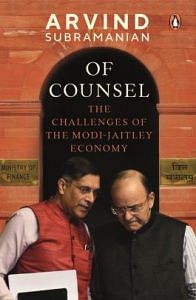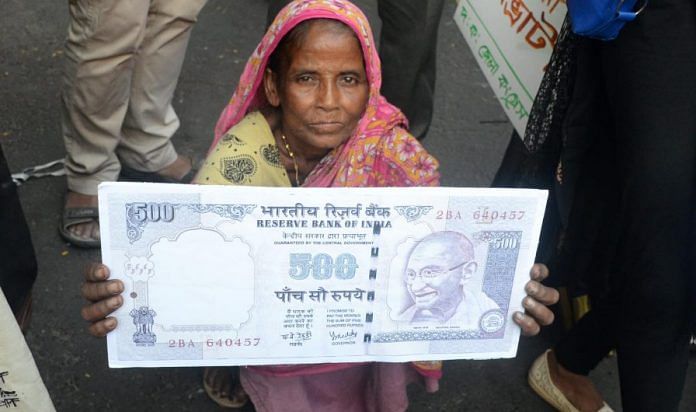The former chief economic adviser talks of the ‘puzzle’ that demonetisation, despite imposing harsh economic costs, was cheered on by its victims.
On 8 November, in a dramatic nationally televised speech that I watched in my room in North Block, the prime minister announced that the top two high-denomination currency notes of Rs 500 and Rs 1000 would cease to be legal tender; that is, they would no longer be accepted as a government-certified means of payment. It was an unprecedented move that no country in recent history had made in normal times. The typical pattern had either been gradual demonetizations in normal times (such as the European Central Bank phasing out the 500-euro note in 2016) or sudden demonetizations in extreme circumstances of war, hyperinflation, currency crises or political turmoil (Venezuela in 2016). The Indian initiative was, to put it mildly, unique. It presupposed an extraordinary amount of resilience in the economy, especially amongst the vulnerable, because it was going to be the first of two major shocks—along with the GST—to affect those in the cash-intensive, informal sectors of the economy.
Two years on, demonetization still consumes the attention of the commentariat, in part because of the mysteries surrounding its origins. I have little to add to the economics of the D-decision beyond what was said in three economic surveys that I oversaw. I do have some new thoughts, or rather hypotheses, on two demonetization puzzles, political and economic.
Puzzle 1: Why was demonetization so popular politically if it imposed economic costs? Specifically, why did demonetization turn out to be an electoral vote winner in the short-term (in the Uttar Pradesh elections of early 2017) if it imposed so much hardship on so many people?
Today, the political perception of demonetization is confounded by a slew of economic and political developments that have occurred since November 2016. Clearly, many factors influence voters’ perceptions and hence affect outcomes, rendering any attempt to tease out cause and effect as unreliable. It is important, however, not to forget history as it happened. At the time (early 2017), the election in Uttar Pradesh—India’s most populous state and the world’s eighth-largest ‘country-that isn’t’—was widely seen as a verdict on demonetization, arguably the salient policy action of the government, personally and forcefully articulated by the prime minister.
The demonetization experiment speaks to the more pervasive and fascinating global phenomenon of What’s the Matter with Kansas?, the title of a famous book by American historian Thomas Frank. This book explores the apparent paradox of citizens voting against their economic self-interest. For example, why do poor white males vote for the Republican Party and President Trump when the policy agenda either has no benefits to them (tax cuts for the rich) or is positively harmful (undermining Obamacare and welfare benefits more broadly)? That same question seemed relevant after the resounding victory of the NDA government in the UP election. This particular piece is an attempt to understand that result as a disinterested observer armed only with publicly known facts. It is not an explanation of the motives of demonetization, simply a post facto analysis of one apparently fascinating political outcome associated with it.
How could demonetization that is supposed to have adversely affected so many Indians—the scores of millions dependent on the cash economy—be so resoundingly supported by the policy’s very (and numerous) victims? I offer the controversial hypothesis that imposing large costs on a wide cross-section of people (and the fact that the Rs 500 and not just the Rs 1000 note was demonetized increased the scope and scale of demonetization’s impact), unexpected and unintentional though it may have been, could actually have been indispensable to achieve political success.
The canonical political economy model of trade explains the persistence of protectionism in terms of an imbalance between the gainers and losers. Protection—which raises domestic prices—helps a few domestic producers a lot while diffusing the harm among many consumers, each of whom loses only a little. Producers, therefore, have both an incentive and ability to lobby for protection, while individual consumers have little incentive to lobby against it. The demonetization case has been very different: hardship was imposed on many and possibly to a great extent, and yet they appear to have been its greatest cheerleaders.
One answer to the demonetization puzzle has been that the poor were willing to overlook their own hardship, knowing that the rich and their ill-begotten wealth were experiencing even greater hardship: ‘I lost a goat but they lost their cows.’ In this view, the costs to the poor were unavoidable collateral damage that had to be incurred for attaining a larger goal.
This is not entirely convincing. After all, the collateral damage was in fact avoidable. Anti-elite populism, or ‘rich bashing’, as the Economist put it, could have taken the form of other punitive actions—taxation, appropriation, raids—targeted just at the corrupt rich.
Why entangle the innocent masses and impoverish them in the bargain? As I wrote in the Economic Survey of 2016–17, if subsidies are a highly inefficient way of transferring resources to the poor, demonetization seemed a highly inefficient way of taking resources away from the rich. Understanding the political economy of demonetization may require us, therefore, to confront one overlooked possibility— that adversely impacting the many, far from being a bug, could perhaps have been a feature of the policy action. Not necessarily by design or in real time, but in retrospect it appears that impacting the many adversely may have been intrinsic to the success of the policy.
Puzzle 2: Why didn’t the draconian 86 per cent reduction in the cash supply have bigger effects on overall economic growth? To put this more provocatively, the question was not whether demonetization imposed costs—it clearly did—but why did it not impose much greater costs?
Demonetization was a massive, draconian, monetary shock: in one fell swoop 86 per cent of the currency in circulation was withdrawn. Figure 1 shows that real GDP growth was clearly affected by demonetization. Growth had been slowing even before, but after demonetization the slide accelerated. In the six quarters before demonetization growth averaged 8 per cent and in the seven quarters after, it averaged about 6.8 per cent (with a four-quarter window, the relevant numbers are 8.1 per cent before and 6.2 per cent after).
I don’t think anyone disputes that demonetization slowed growth. Rather, the debate has been about the size of the effect, whether it was 2 percentage points, or much less. After all, many other factors affected growth in this period, especially higher real interest rates, GST implementation and rising oil prices.
I do not have a strongly backed empirical view apart from the fact that the welfare costs especially on the informal sector were substantial.
As a monetary economist, though, what is striking is how small the effect was compared to the magnitude of the shock. There are many ways of seeing this. Figure 2 compares what happened to cash with what happened to nominal GDP. It is a stunning picture. Prior to demonetization, cash and GDP move closely together. Then, currency collapses and recovers (the dotted line), but through all of this, the economy seems to have been chugging along almost unmindful of the currency in circulation. You have to squint to see any downward movement of the solid black line (for nominal GDP) after demonetization: in fact, there isn’t, and all the downward blips reflect seasonality, which leads to a lower level of activity in the first (April–June) quarter every year.
What could possibly explain this apparent resilience? A number of hypotheses need to be considered. First and foremost, it could simply be an artefact of the way that GDP numbers are created. In India, there are no timely measures of informal sector activity, so it is proxied by formal sector indicators. Normally, this is not a problem, since the two move in tandem. But when a shock like demonetization occurs that primarily affects the informal sector, relying on formal indicators to measure overall activity will overstate GDP.
This hypothesis goes only a small way towards explaining the puzzle, since any squeeze in informal sector incomes would depress demand in the formal sector, and this effect should have been sizable.
As a result, we need to search for other explanations. One possibility is that people found ways around the note ban, for example by continuing to use the Rs 500 note even after its use had been formally banned, so the currency shock wasn’t actually as big as conventionally measured. Another possibility is that production was sustained by extending informal credit: people simply agreed to pay their bills as soon as currency became available. Finally, to a certain extent, people may have shifted from using cash to paying by electronic means, such as debit cards and electronic wallets.
Or, there may be other, completely different explanations that have eluded my understanding of demonetization, one of the unlikeliest economic experiments in modern Indian history.
 This book excerpt was published with permission from the book ‘Of Counsel: The Challenges of the Modi-Jaitley Economy’, written by Arvind Subramanian and published by Penguin Viking.
This book excerpt was published with permission from the book ‘Of Counsel: The Challenges of the Modi-Jaitley Economy’, written by Arvind Subramanian and published by Penguin Viking.




Arvind Subramanian is admitting now what “intuitive” economists like me have been saying ever since the demonetization happened. So a related question is, when demonetization cruelly disrupted poor people’s lives, then so close on its heels, how did the BJP win U.P. elections? That means, to put it indirectly, the BJP knows SOME “METHOD” OF WINNING ELECTIONS!!
When the country’s CEA learns of demonetisation – like the rest of us – by watching TV, that says a lot about the intellectual rigour that marked the decision. Dr Singh’s estimate of loss of 2% GDP is convincing. The effects on the economy are still playing out, along with the double helix of GST. To the extent that this measure has caused so much economic harm to virtually every section of society, it has hurt the incumbent’s Report Card. If a second term does not materialise, pencil in this as a major contributor.